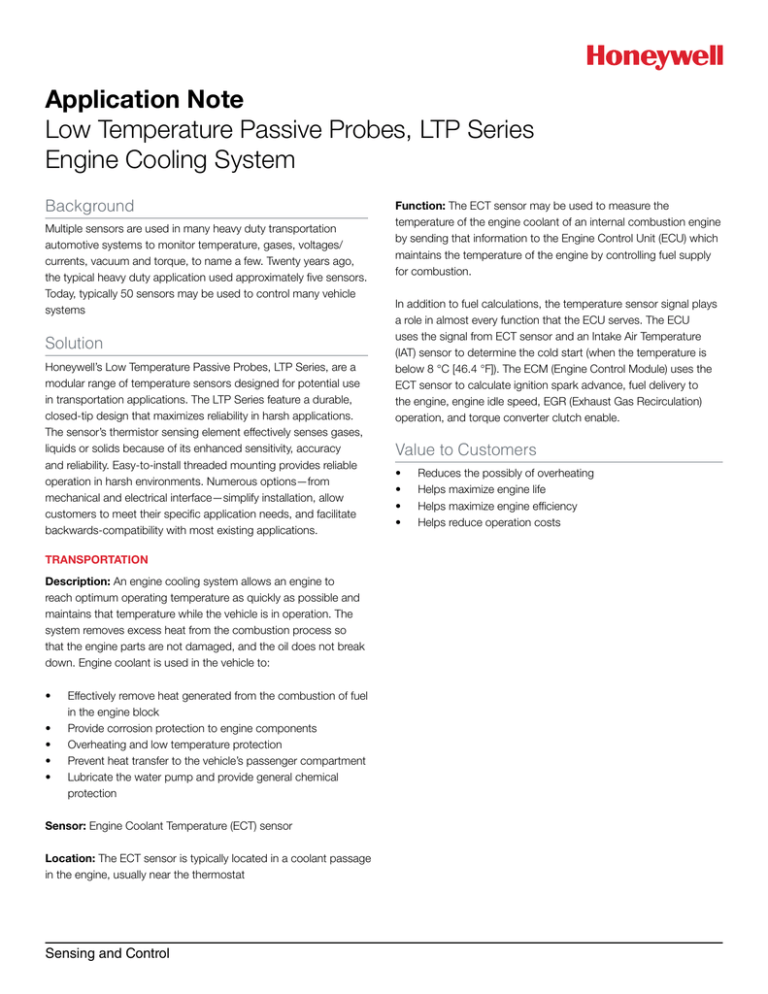
Application Note
Low Temperature Passive Probes, LTP Series
Engine Cooling System
Background
Multiple sensors are used in many heavy duty transportation
automotive systems to monitor temperature, gases, voltages/
currents, vacuum and torque, to name a few. Twenty years ago,
the typical heavy duty application used approximately five sensors.
Today, typically 50 sensors may be used to control many vehicle
systems
Solution
Honeywell’s Low Temperature Passive Probes, LTP Series, are a
modular range of temperature sensors designed for potential use
in transportation applications. The LTP Series feature a durable,
closed-tip design that maximizes reliability in harsh applications.
The sensor’s thermistor sensing element effectively senses gases,
liquids or solids because of its enhanced sensitivity, accuracy
and reliability. Easy-to-install threaded mounting provides reliable
operation in harsh environments. Numerous options—from
mechanical and electrical interface—simplify installation, allow
customers to meet their specific application needs, and facilitate
backwards-compatibility with most existing applications.
TRANSPORTATION
Description: An engine cooling system allows an engine to
reach optimum operating temperature as quickly as possible and
maintains that temperature while the vehicle is in operation. The
system removes excess heat from the combustion process so
that the engine parts are not damaged, and the oil does not break
down. Engine coolant is used in the vehicle to:
•
•
•
•
•
Effectively remove heat generated from the combustion of fuel
in the engine block
Provide corrosion protection to engine components
Overheating and low temperature protection
Prevent heat transfer to the vehicle’s passenger compartment
Lubricate the water pump and provide general chemical
protection
Sensor: Engine Coolant Temperature (ECT) sensor
Location: The ECT sensor is typically located in a coolant passage
in the engine, usually near the thermostat
Sensing and Control
Function: The ECT sensor may be used to measure the
temperature of the engine coolant of an internal combustion engine
by sending that information to the Engine Control Unit (ECU) which
maintains the temperature of the engine by controlling fuel supply
for combustion.
In addition to fuel calculations, the temperature sensor signal plays
a role in almost every function that the ECU serves. The ECU
uses the signal from ECT sensor and an Intake Air Temperature
(IAT) sensor to determine the cold start (when the temperature is
below 8 °C [46.4 °F]). The ECM (Engine Control Module) uses the
ECT sensor to calculate ignition spark advance, fuel delivery to
the engine, engine idle speed, EGR (Exhaust Gas Recirculation)
operation, and torque converter clutch enable.
Value to Customers
•
•
•
•
Reduces the possibly of overheating
Helps maximize engine life
Helps maximize engine efficiency
Helps reduce operation costs
Application Note
Low Temperature Passive Probes, LTP Series
Engine Cooling System
LTP Series
Bosch Kompact
Delphi Metri-Pack 150 Series
AMP Seal 16
AMP Minitimer
AMP Superseal
Deutsch DT04-2P
Find out more
To learn more about Honeywell Sensing
and Productivity Solutions’ products, call
+1-815-235-6847 or 1-800-537-6945,
visit sensing.honeywell.com, or e-mail
inquiries to info.sc@honeywell.com
Features
• Temperature range: -40 °C to 150 °C [-40 °F to 302 °F]
• Response time [T63.2% of 25 °C to 85 °C step]: stirred silicon
oil <15 s; stirred water <15 s; air flow 10 m/s <20 s
•Accuracy:
- -40 °C to 25 °C [-40 °F to 77 °F]: ±2.5 °C
- 25 °C to 100 °C [77 °F to 212 °F]: ±0.8 °C
- 100 °C to 125 °C [212 °F to 257 °F]: ±2.0 °C
- 125 °C to 150 °C [257 °F to 302 °F]: ±3.5 °C
• Electrical interface: Bosch Kompakt, Delphi Metri-Pack 150
Series, AMP Seal 16, AMP Minitimer, AMP Superseal, and
Deutsch DT04-2P
• Probe length options: 20 mm to 50 mm (other lengths available
upon request)
• Mechanical fastening options: M10 to M18, 3/4 UNF, and
G 1/4 (other threads available on request)
• Retainer ring with hex: provides complete location for socket
wrench in axial and radial directions, enabling the operator
to first locate the sensor inside the socket to freely and more
easily install the sensor
• Insulation resistance between I/O pin and the sensor’s
housing: >10 MOhm at 250 Vdc, 25 °C [77 °F]
• Ingress protection: IP67
• Vibration: 30 g sine wave,10 Hz to 2000 Hz
• Mechanical shock: 50 g
• Service pressure: 10 bar
• Burst pressure: 40 bar
• Wire harness (with or without a connector) or other sensing
elements (PTC or RTD) available upon request
Warranty. Honeywell warrants goods of its manufacture as being free of defective materials
and faulty workmanship. Honeywell’s standard product warranty applies unless agreed to
otherwise by Honeywell in writing; please refer to your order acknowledgement or consult
your local sales office for specific warranty details. If warranted goods are returned to
Honeywell during the period of coverage, Honeywell will repair or replace, at its option,
without charge those items it finds defective. The foregoing is buyer’s sole remedy and
is in lieu of all warranties, expressed or implied, including those of merchantability
and fitness for a particular purpose. In no event shall Honeywell be liable for
consequential, special, or indirect damages.
While we provide application assistance personally, through our literature and the Honeywell
web site, it is up to the customer to determine the suitability of the product in the application.
Specifications may change without notice. The information we supply is believed to be
accurate and reliable as of this printing. However, we assume no responsibility for its use.
Sensing and Productivity Solutions
Honeywell
1985 Douglas Drive North
Golden Valley, MN 55422
honeywell.com
009083-2-EN IL50
March 2016
Copyright © 2016 Honeywell International Inc. All rights reserved.

